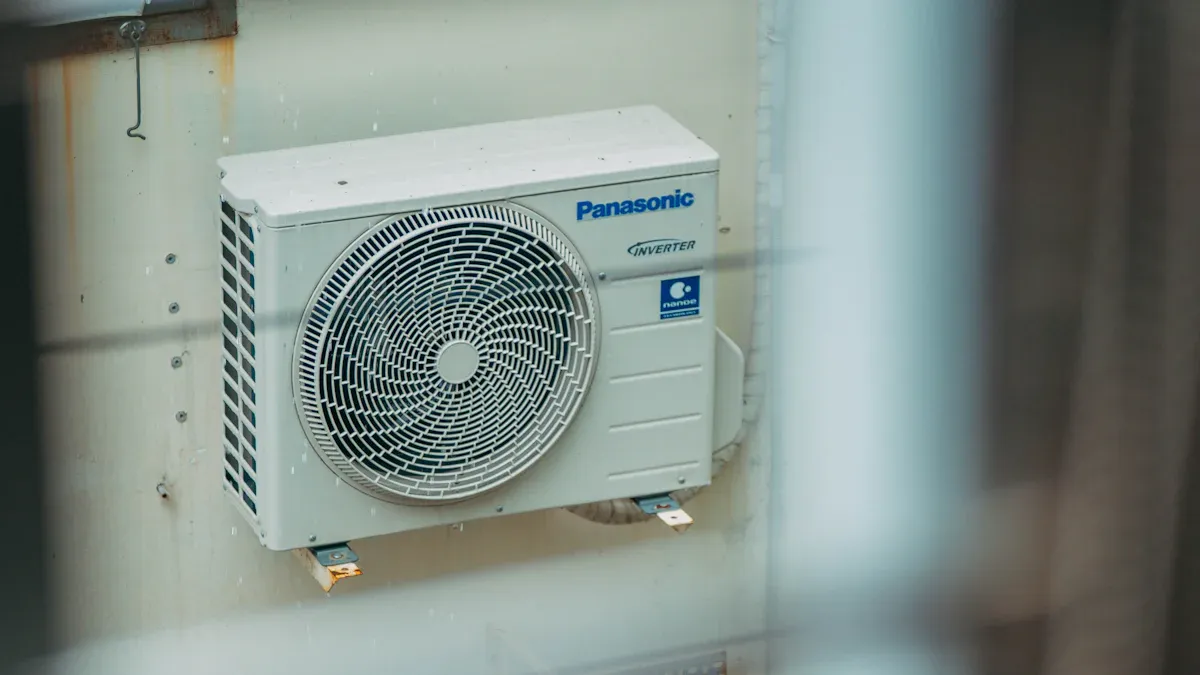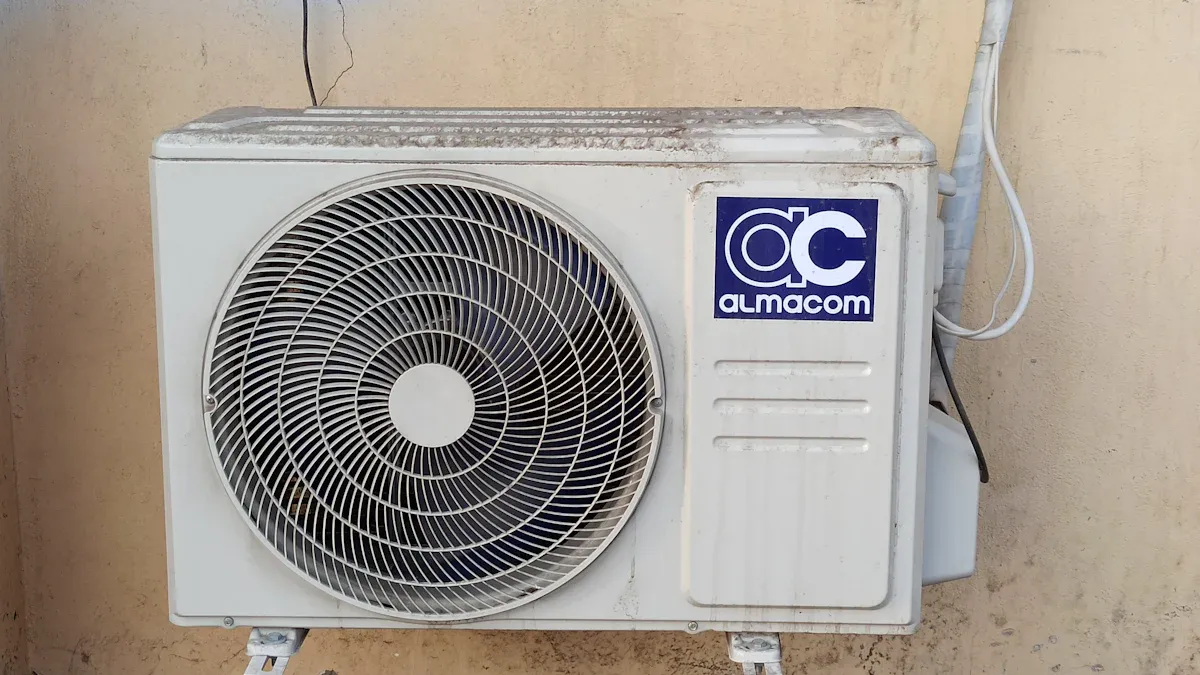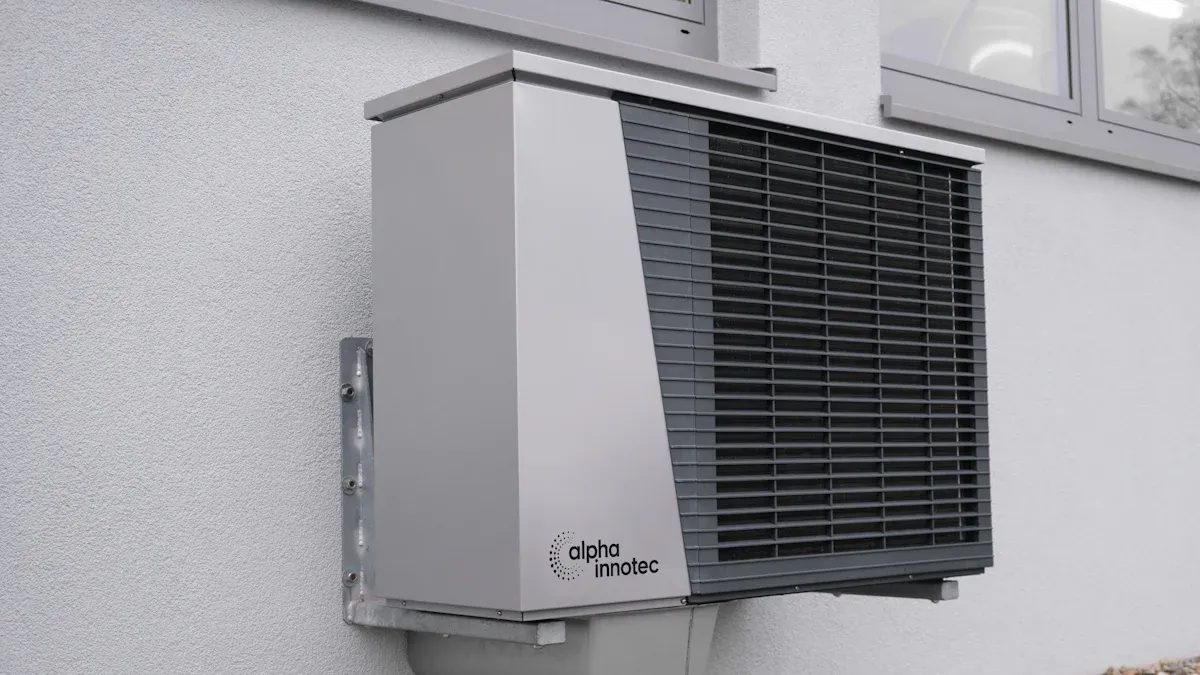Copper vs. Aluminum Tube Condensers: 5-Year Total Cost Comparison

When comparing copper and aluminum tube condensers, the cost differences over a 5-year period become evident. Copper, priced at approximately $3.00 per pound, has a higher initial cost than aluminum, which costs around $1.60 per pound. However, copper's durability and energy efficiency often lead to long-term savings. Aluminum, while cheaper upfront, may result in higher energy expenses over time. Evaluating total costs, including maintenance and performance, is crucial for making an informed decision. Companies like Senjun, specializing in wire tube condenser production, play a vital role in delivering reliable solutions for various industries.
Key Takeaways
- Copper condensers use less energy, saving money on electricity over time.
- Aluminum costs less at first, but copper lasts longer with fewer repairs.
- Copper cools faster because it transfers heat better than aluminum.
- Think about all costs, like energy and repairs, before deciding.
- Copper condensers are reliable and save money in tough conditions.
Initial Costs
Material Costs
When evaluating the initial costs of copper and aluminum tube condensers, material pricing plays a significant role. Copper, known for its durability and efficiency, comes at a higher price point. Aluminum, on the other hand, is more affordable, making it a popular choice for budget-conscious projects. Here's a quick comparison of the current market prices:
| Material | Price Range (per kg) | Cost-Effectiveness |
|---|---|---|
| Aluminum | $2 - $3 | More cost-effective |
| Copper | $6 - $10 | Higher efficiency and durability |
While aluminum's lower cost makes it attractive for initial purchases, copper's long-term benefits often outweigh the upfront expense. For instance, copper condensers are more efficient and durable, which can lead to reduced energy and maintenance costs over time. This balance between affordability and performance is crucial when deciding on the right material for your condenser.
Installation Costs
Installation costs also vary depending on the material used. Aluminum condensers are lighter, which simplifies the installation process and reduces labor expenses. Copper condensers, being heavier, may require more effort and time to install. However, the difference in installation costs is often minimal compared to the overall project budget.
- Aluminum's lightweight nature makes it easier to handle during installation.
- Copper, despite being heavier, offers long-term financial sustainability due to its durability and efficiency.
For projects with tight budgets, aluminum may seem like the better option. However, I always recommend considering the total cost of ownership, including energy efficiency and maintenance, before making a decision. Companies like Senjun, with their expertise in wire tube condenser production, provide high-quality solutions that cater to both copper and aluminum options, ensuring you get the best value for your investment.
Efficiency and Performance

Energy Efficiency Comparison
When comparing the energy efficiency of copper and aluminum tube condensers, copper consistently outperforms aluminum. Its superior thermal conductivity, rated at 38, allows for faster heat transfer, which directly translates to energy savings. Aluminum, with a thermal conductivity of 175, lags behind in this regard. This difference becomes evident in systems like air conditioners, where efficient heat transfer is critical.
| Feature | Copper Condensers | Aluminum Condensers |
|---|---|---|
| Thermal Conductivity | Higher thermal conductivity, leading to faster cooling | Lower thermal conductivity, slower cooling |
| Specific Heat | Lower specific heat, heats up and cools down faster | Higher specific heat, slower response |
| Cost-Effectiveness | More expensive but offers better energy savings | Generally cheaper but less efficient |
Copper's lower specific heat also contributes to its efficiency. It heats up and cools down faster, ensuring optimal performance in fluctuating conditions. I often recommend copper for applications where energy efficiency is a priority. While aluminum may seem cost-effective initially, its lower efficiency can lead to higher energy bills over time.
Cooling Performance Over Time
Over the years, copper condensers maintain their cooling performance better than aluminum. Copper's strength and durability ensure consistent heat transfer, even in demanding environments. Aluminum, on the other hand, is more prone to damage and corrosion, which can degrade its performance.
- Copper provides superior heat transfer characteristics, ensuring reliable cooling.
- Aluminum coils are harder to clean and more susceptible to wear, impacting long-term efficiency.
For example, copper's durability makes it easier to maintain, reducing the risk of performance loss due to damage or corrosion. This reliability is why I often see copper used in high-performance systems like medical ultra-low temperature refrigerators and dehumidifiers. Companies like Senjun, known for their expertise in wire tube condenser production, leverage copper's advantages to deliver products that excel in both efficiency and longevity.
Durability and Corrosion Resistance

Longevity of Copper vs. Aluminum
When it comes to longevity, copper stands out as the more durable option. Its robust structure and resistance to wear ensure a longer lifespan compared to aluminum. In my experience, copper condensers often outperform aluminum in demanding applications like medical ultra-low temperature refrigerators and dehumidifiers. This durability translates to fewer replacements and lower long-term costs.
Aluminum, while cost-effective upfront, has a shorter lifespan. It is more prone to physical damage, especially in high-pressure systems. However, its lightweight nature can reduce strain on the overall system, which may contribute to slightly lower maintenance costs over time. For instance:
- Copper generally lasts longer due to its superior strength and resistance to corrosion.
- Aluminum, though less durable, can still be a viable choice for budget-conscious consumers.
For applications requiring consistent performance over many years, I recommend copper. Its efficiency and durability make it a reliable investment, especially in industries where reliability is critical.
Corrosion Resistance in Different Environments
Corrosion resistance is another critical factor when comparing copper and aluminum. Copper offers excellent resistance to rust and environmental factors, making it ideal for use in humid or salty environments. However, even copper can corrode if not properly maintained. Aluminum, on the other hand, is more susceptible to corrosion, especially when exposed to certain coolants or harsh environmental conditions. This susceptibility can lead to leaks and reduced performance over time.
Historically, issues have arisen with aluminum due to galvanic action when it interfaces with copper. This highlights the importance of proper design and maintenance. For example:
- Copper's anti-corrosive properties enhance its lifespan in HVAC applications.
- Aluminum requires additional protective measures, such as antioxidants, to mitigate corrosion risks.
In my opinion, copper remains the superior choice for environments prone to corrosion. Companies like Senjun leverage copper's advantages to produce high-quality wire tube condensers that perform reliably in various industries.
Maintenance and Repairability
Ease of Maintenance
When it comes to maintenance, copper tube condensers have a clear advantage over aluminum. Copper's strength and reliability make it easier to clean and maintain, even in demanding environments. Aluminum, on the other hand, often requires more effort due to its susceptibility to damage and oxidation. Based on my experience, copper condensers are more forgiving during routine maintenance, which reduces the likelihood of performance issues.
Here’s a quick comparison of maintenance ease between the two materials:
| Evidence Source | Key Point |
|---|---|
| ACHR News | Copper tubes with aluminum fins are superior due to strength and ease of maintenance. |
| American Cooling and Heating | Copper is easier to maintain; aluminum leaks are harder to fix. |
| Times of India | Copper condensers are easier to repair on-site compared to aluminum. |
| Copper Pipe | Aluminum requires checks for oxidation, while copper needs corrosion prevention. |
| Rahn Industries | Copper is preferred for field repairs, unlike aluminum. |
From my perspective, copper's ease of maintenance makes it the better choice for applications requiring consistent upkeep, such as medical refrigerators or dehumidifiers. Companies like Senjun, known for their expertise in wire tube condenser production, leverage copper's advantages to deliver reliable and low-maintenance solutions.
Repair Costs and Availability of Parts
Repairability is another area where copper outshines aluminum. Copper condensers are easier to repair on-site, which minimizes downtime and reduces costs. Aluminum, however, often requires specialized fittings or complete replacement due to its fragility. This can lead to higher repair expenses and longer system downtimes.
| Feature | Copper Condensers | Aluminum Condensers |
|---|---|---|
| Repairability | Easier to maintain and repair | Harder to maintain and prone to damage |
| Downtime | Less downtime due to easier repairs | Increased downtime due to difficult repairs |
| Cost of Repairs | Generally lower due to easier repairability | Higher due to challenges in repairs |
In my experience, fixing leaks in aluminum condensers is particularly challenging. It often requires specialized tools and fittings, making on-site repairs impractical. In many cases, replacing the entire unit becomes more cost-effective after five years. Copper, by contrast, allows for quicker and more affordable repairs, ensuring minimal disruption to operations.
For industries relying on uninterrupted performance, such as refrigeration or HVAC systems, copper condensers provide a dependable and cost-effective solution. Senjun’s expertise in manufacturing high-quality wire tube condensers ensures that their products meet the highest standards of repairability and durability.
Long-Term Cost Analysis
Energy Costs Over 5 Years
Energy costs play a significant role in the total cost of ownership for condensers. Over a 5-year period, copper condensers often result in lower energy expenses due to their superior thermal conductivity. Copper transfers heat more efficiently, reducing the workload on cooling systems. This efficiency directly translates into energy savings, especially in applications like medical refrigerators and dehumidifiers. Aluminum, while more affordable upfront, tends to consume more energy over time because of its lower thermal conductivity. This difference becomes evident in energy-intensive environments, where operational costs can quickly add up.
Maintenance and Repair Costs Over 5 Years
Maintenance and repair costs also vary significantly between copper and aluminum condensers. Copper's durability reduces the frequency of repairs, leading to lower maintenance expenses over time. Aluminum, being more prone to damage and corrosion, often requires more frequent repairs. For example, tube leaks in aluminum condensers can occur twice a year during peak seasons, causing operational disruptions. Each repair can result in substantial income losses, especially in industries relying on consistent performance. Copper condensers, on the other hand, are easier to maintain and repair, minimizing downtime and associated costs.
Replacement Costs (if applicable)
Replacement costs depend on the lifespan of the condenser material. Copper condensers typically last 10 to 15 years, making replacements less frequent. Aluminum condensers, while initially cheaper, may require replacement sooner due to their shorter lifespan and susceptibility to wear. This difference in longevity makes copper a more cost-effective choice in the long run. For industries requiring reliable performance, such as refrigeration and HVAC systems, investing in copper condensers ensures fewer replacements and lower overall costs. Companies like Senjun, known for their expertise in wire tube condenser production, provide durable solutions that maximize value over time.
Wire Tube Condenser and Senjun's Role
Overview of Wire Tube Condensers
Wire tube condensers play a crucial role in cooling systems by efficiently transferring heat from refrigerants to the surrounding environment. These condensers are widely used in refrigeration and HVAC systems due to their simple design, cost-effectiveness, and reliability. Their structure, which typically consists of coiled tubes and fins, maximizes surface area for heat exchange. This design ensures optimal performance in applications ranging from household refrigerators to industrial cooling systems.
Wire tube condensers are particularly valued for their durability and ease of maintenance. Their robust construction allows them to withstand demanding conditions, making them a preferred choice in industries requiring consistent cooling performance. As energy efficiency becomes a global priority, the demand for advanced wire tube condensers continues to grow.
Senjun's Expertise in Copper and Aluminum Condensers
Senjun has established itself as a leader in the cooling industry since its inception in 2010. The company specializes in the research, development, and production of wire tube condensers and copper-aluminum fin heat exchangers. Its expertise in manufacturing both copper and aluminum condensers is evident in the innovative features of its products.
The copper tube aluminum fin condenser, for instance, combines the superior heat transfer capabilities of copper with the lightweight and corrosion-resistant properties of aluminum. This design not only enhances energy efficiency but also aligns with global efforts to reduce emissions. Senjun employs advanced manufacturing techniques, such as laser welding and CAD, to ensure precision and efficiency. The company also focuses on eco-friendly designs, incorporating features like reduced refrigerant usage and IoT integration for smarter energy management.
| Feature | Description |
|---|---|
| Enhanced Materials | New copper alloys and optimized aluminum fins improve durability and heat transfer. |
| Improved Manufacturing Processes | Techniques like laser welding and CAD enhance precision and efficiency. |
| Eco-Friendly Designs | Reduced refrigerant usage and exploration of natural refrigerants align with sustainability goals. |
| Smart Condensers | IoT integration and adaptive control features enhance energy efficiency and monitoring. |
Applications of Senjun's Products in Various Industries
Senjun's products serve a wide range of industries, showcasing their versatility and reliability. These include:
- Refrigeration: Used in refrigerators, freezers, and wine cabinets for consistent cooling.
- Medical Equipment: Essential in ultra-low temperature refrigerators for preserving sensitive materials.
- Commercial Appliances: Found in display cabinets and ice makers for efficient operation.
- Dehumidification: Integrated into dehumidifiers to maintain optimal humidity levels.
Senjun's commitment to quality and innovation ensures its products meet the diverse needs of these industries. By leveraging its expertise in wire tube condenser technology, the company continues to deliver solutions that excel in performance, durability, and energy efficiency.
After analyzing the cost, efficiency, and maintenance aspects, I find copper condensers to be the superior choice for long-term value. Copper offers unmatched durability and thermal conductivity, ensuring better energy efficiency and lower maintenance costs over five years. While aluminum condensers are more affordable upfront, their higher energy consumption and frequent repairs can offset the initial savings.
For industries requiring reliable cooling solutions, I recommend copper condensers for their consistent performance and cost-effectiveness. Companies like Senjun excel in producing high-quality wire tube condensers and copper-aluminum fin heat exchangers. Their innovative designs cater to diverse applications, ensuring efficiency and durability across various industries.
FAQ
What are the main advantages of copper tube condensers?
Copper tube condensers excel in durability, thermal conductivity, and ease of maintenance. They offer superior energy efficiency, reducing long-term costs. Their robust structure ensures reliable performance in demanding environments, making them ideal for industries like medical refrigeration and HVAC systems.
Are aluminum tube condensers suitable for all environments?
Aluminum tube condensers perform well in standard conditions but struggle in humid or corrosive environments. They require additional protective measures to prevent oxidation. For applications in harsh conditions, I recommend copper condensers due to their superior corrosion resistance.
How does Senjun ensure the quality of its condensers?
Senjun employs advanced manufacturing techniques like laser welding and CAD to ensure precision. The company uses high-quality materials and integrates eco-friendly designs. Its focus on innovation and rigorous quality control guarantees reliable and efficient products for various industries.
Which industries benefit most from wire tube condensers?
Wire tube condensers serve industries like refrigeration, medical equipment, and dehumidification. They are essential in refrigerators, ultra-low temperature medical freezers, and dehumidifiers. Their durability and efficiency make them a preferred choice for consistent cooling performance.
Why is long-term cost analysis important when choosing a condenser?
Long-term cost analysis helps evaluate energy efficiency, maintenance, and replacement expenses. While aluminum condensers may seem cheaper upfront, copper condensers often provide better value over time. This approach ensures informed decisions that align with budget and performance needs.


















